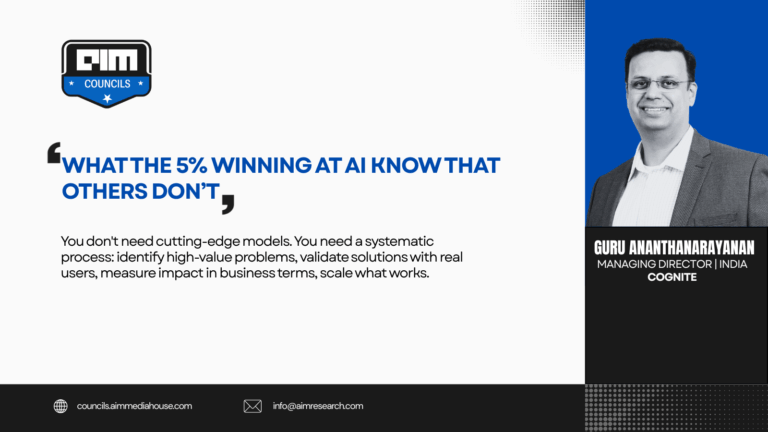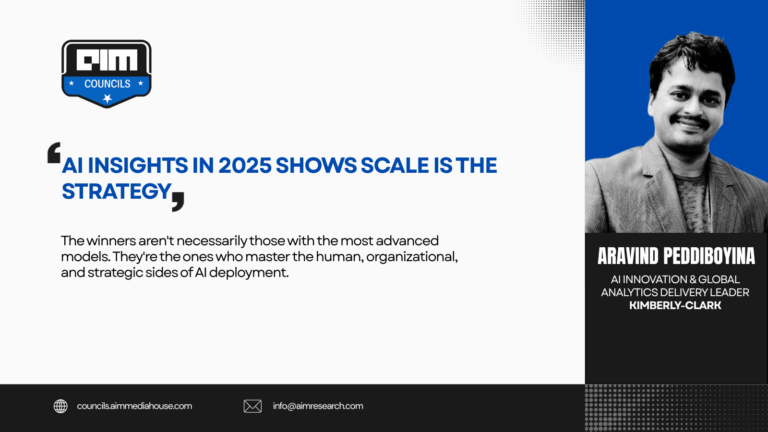The artificial intelligence revolution is unfolding against a backdrop of unprecedented geopolitical complexity. As nations race to establish their digital sovereignty and AI supremacy, organizations operating across borders find themselves navigating an increasingly fragmented regulatory landscape that fundamentally challenges how they innovate, collaborate, and compete. These themes were explored in depth during the roundtable discussion hosted by the AIM Leaders Council, featuring Gurbans Chatwal (Vice President, Innovation & Intelligent Automation at Fiserv), Snigdha Ghosh Ray (VP, Banking & Payment and India R&D Hub Lead at Diebold Nixdorf), Santosh Karthikeyan Viswanathan (Global Technical Director, Clinical Data & Insights at AstraZeneca), Dr. Saurabh Pramanick (Data Governance Officer – Data Governance Council at Bank Muscat), and Padmanabh Padiyar (Executive Director – Head of Transformation at OCBC Bank).
The Great Regulatory Divide
The global AI ecosystem has crystallized into distinct regulatory ideologies that reflect deeper cultural and strategic priorities. Europe has emerged as the architect of comprehensive AI governance, with the EU AI Act representing the most thorough regulatory framework to date. This approach prioritizes trust-building and ethical AI deployment over rapid innovation, with European policymakers betting that long-term competitive advantage will come from establishing trustworthy AI systems rather than rushing to market with the largest models.
The penalties embedded in the EU AI Act surpass even those of GDPR, signaling Europe’s serious commitment to AI governance. Organizations operating in European markets must navigate these comprehensive requirements, which often slow innovation cycles but promise greater regulatory certainty once compliance is achieved.
In contrast, the United States maintains a lighter regulatory touch, favoring innovation-first policies that allow companies like Google and OpenAI to move aggressively in AI development. However, this apparent simplicity masks a complex reality of state-level variations, with jurisdictions like California implementing their own nuanced AI regulations. For global organizations, this creates a patchwork compliance challenge where applications spanning different US states require careful regulatory mapping.
The Asian Paradigm
Asian markets present yet another regulatory paradigm, particularly evident in the experiences of financial institutions operating across the region. Singapore exemplifies a balanced approach where sectoral governance predominates, allowing innovation within regulated frameworks as long as customer consent and data protection requirements are met. The state maintains oversight but doesn’t dictate specific technological choices.
China and Indonesia represent a different model entirely, where state control extends beyond sectoral regulation to direct influence over AI deployment decisions. This creates significant operational friction for multinational organizations seeking to standardize AI applications across regions. The inability to share data across borders in these markets forces companies to develop localized AI capabilities, fragmenting what could otherwise be unified AI centers of excellence.
The implications extend beyond mere compliance costs. Organizations find themselves forced to make strategic choices about which models and technologies to deploy based not just on technical merit, but on geopolitical considerations. The origin country of an AI model can determine its acceptability in certain markets, while hardware restrictions add another layer of complexity to deployment decisions.
Industry-Specific Challenges
The regulatory complexity manifests differently across industries, with financial services and healthcare facing particularly stringent requirements. In the payments industry, organizations must navigate not only AI-specific regulations but also existing banking and financial services frameworks, data protection laws, and now generative AI governance requirements. This creates what industry leaders describe as a multi-layered compliance challenge where every AI implementation requires careful orchestration across multiple regulatory domains.
The pharmaceutical industry faces similar complexity, where AI implementations must satisfy platform compliance requirements, cybersecurity assessments, and partner ecosystem evaluations. The industry’s naturally conservative approach to new technology adoption, driven by patient safety considerations, creates additional friction when implementing AI solutions that require rapid iteration and learning.
These sector-specific challenges are compounded by the emergence of cross-border data restrictions. Financial institutions operating across multiple Asian markets, for example, cannot freely share transaction data between subsidiaries due to data localization requirements, forcing the creation of separate AI capabilities in each jurisdiction despite the obvious inefficiencies.
The Talent and Innovation Paradox
Contrary to concerns about brain drain, the AI revolution has actually created new opportunities for talent distribution. Indian technology professionals, in particular, have found AI to be a great equalizer in global collaboration. Where traditional technology transfers often favored established locations with domain expertise, AI implementation success depends more on adaptability and willingness to learn than geographical advantage.
However, a critical distinction has emerged between applied AI and foundational AI research. While India excels in building applications on top of existing foundation models, leveraging abundant data and strong digital infrastructure, the country lags in developing foundational AI models and conducting core AI research. This creates a strategic vulnerability in the geopolitical AI landscape, where control over foundational models translates to significant influence over downstream applications.
The concern extends beyond brain drain to what industry experts describe as data drain. In an AI-driven economy, access to and control over high-quality data becomes as strategically important as traditional natural resources. Organizations find themselves caught between the need to leverage global data for AI training and increasingly strict data localization requirements that prevent cross-border data movement.
The Semiconductor Dimension
The AI geopolitics story cannot be told without acknowledging the semiconductor supply chain that underpins all AI capabilities. Recent disruptions in global chip supplies have highlighted how hardware dependencies create new forms of geopolitical leverage. Organizations implementing AI solutions must now consider not just software restrictions but also hardware availability and compliance requirements.
This hardware dimension affects everything from data center location decisions to model deployment strategies. Companies are increasingly forced to maintain separate AI infrastructure stacks for different geopolitical regions, dramatically increasing costs and complexity while reducing the potential benefits of AI scale economies.
Collaboration in Competition
Despite these challenges, a surprising trend toward collaboration has emerged within the AI ecosystem. Rather than engaging in zero-sum competition, organizations are finding ways to share knowledge and resources while navigating regulatory constraints. Industry forums and professional networks have become crucial venues for sharing compliance strategies and technical approaches.
The financial services industry exemplifies this collaborative approach, where institutions work together to understand regulatory requirements and share best practices for AI implementation. Clean room technologies and privacy-preserving computation methods are enabling new forms of data collaboration that respect regulatory boundaries while still allowing organizations to benefit from collective intelligence.
However, this collaboration occurs against a backdrop of increasingly blurred competitive boundaries. Technology giants like Google and Amazon have expanded into payments and financial services, while traditional financial institutions develop their own AI capabilities. The result is an ecosystem where yesterday’s partners might become tomorrow’s competitors, and traditional industry boundaries no longer define competitive landscapes.
The Path Forward
Organizations navigating this complex environment are adopting several key strategies. Process-driven approaches that embed regulatory compliance into AI development lifecycles from the beginning are becoming standard practice. Hub-and-spoke governance models that centralize regulatory oversight while allowing localized implementation are proving effective for multinational organizations.
Investment in external consulting partnerships has become essential for tracking the rapidly evolving regulatory landscape across multiple jurisdictions. Organizations can no longer rely on internal legal teams alone to navigate the complexity of global AI regulation.
Perhaps most importantly, successful organizations are learning to view regulatory compliance not as a barrier to innovation but as a competitive advantage. Those who master the art of compliant AI development gain sustainable advantages in markets where regulatory scrutiny is increasing.
Conclusion
Success in this environment requires more than technical excellence. It demands regulatory sophistication, strategic partnerships, and the ability to innovate within constraints while building capabilities that transcend geographical boundaries. As AI becomes increasingly central to economic competitiveness, mastering these geopolitical dimensions will separate the leaders from the followers in the next phase of technological evolution.
The future belongs to organizations that can turn regulatory complexity into competitive advantage, transforming constraints into catalysts for more thoughtful, sustainable, and ultimately more successful AI implementation. In a fragmented world, the ability to unite diverse requirements into coherent strategies may prove to be the most valuable AI capability of all.
Disclaimer: All views expressed by Santosh are personal and should not be considered as attributable to his employer.







